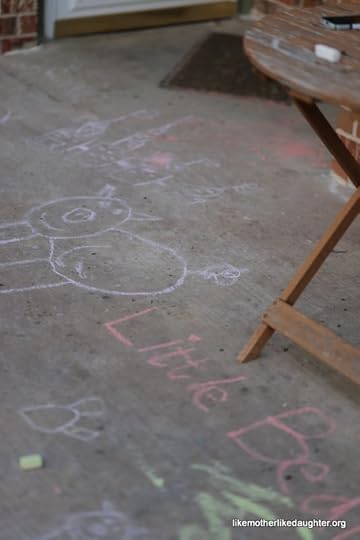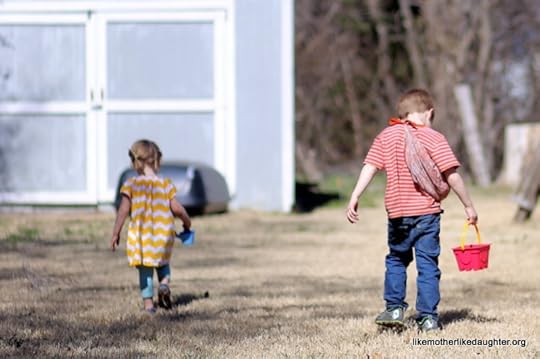Leila Marie Lawler's Blog, page 54
March 19, 2016
{bits & pieces}
The weekly “little of this, like of that” feature here at Like Mother, Like Daughter!

Got it into my head to make Easter (or just Spring, if preferred) dresses and bow ties… Will update you…
A very blessed Solemnity of St. Joseph to you!
From today’s Office of Readings:
In him the Old Testament finds its fitting close. He brought the noble line of patriarchs and prophets to its promised fulfilment. What the divine goodness had offered as a promise to them, he held in his arms.
Go to Joseph, as the Egyptians said, so long ago. Go to him with your deepest thoughts, hurts, and problems. He has the dear Jesus in his arms.
Also, thanks so much to those who read/are reading along with our Spirit of the Liturgy Book Club. All comments are welcome, and feel free to jump in at any time — no apology needed for being late or anything else. We are done with that book and will take a brief respite before tackling the other one. (Details in that last post.)
As you know, I’m pretty impatient with links to videos. If we post one here, it’s of cats doing amazing things, or of something else equally gripping. Do watch this one if you have time. Eric Genuis (pronounced “genus”), composer and pianist, is simply bringing beauty to those in prison, who likely don’t encounter it very often. Beauty can change a life.
Have you ever seen crucifixes covered in violet cloth in Church, or heard of Passiontide, the time at the end of Lent, before Easter?
Fr. James Schall, SJ: what kind of regime do we live under? (Long read.)
I worry that people don’t teach their children first aid and safety rules. In my day, it was all bleeding from major arteries (tourniquets figured largely, although turns out they aren’t always the best idea) and quicksand (you really, really hope that there is a large sturdy branch nearby!). I dunno — we spent a lot of time reading safety tips. What to do if someone falls through the ice, how to recognize and treat shock, spotting a rabid dog… Would you recognize the danger of downed wires? Would your children? Here’s another video — it’s kind of stage-y (my kids would have mocked him mercilessly) but I think the kids would remember the lessons, as it’s well done after all. Very dramatic.
An interesting post from Msgr. Pope about how the early church was not informal, as many have taught (but no, no to cry rooms, because it’s not at all the same thing).
The Sacredness of Marriage: A Lesson from the Pagans
Remember when I was lamenting the demise of the old Gourmet magazine (and by the way, heads up in that post: Easter dessert alert!)? Since we are planning our trip to Europe, I was searching old Gourmet archives and found this amazing article. Unheard of detail and laconic prose. Of course, missing are the fantastic pictures that Gourmet was always known for. Maybe I actually have this issue…
So now I am intrigued. What do you think about the Insta-pot? Do you have one? Talk to me.
From the archives:
For some reason I have money on my mind.
Ask Auntie Leila: 10 Reasons not to have separate finances in your marriage.
Two big ways to save money — beyond re-using coffee grounds, how to break the back of your debt.
Cut back on 5 big wedding expenses
Just re-upping these posts for getting ready for Easter.
Dear Auntie Leila: I don’t know what to do for Easter
Thinking about Holy Thursday, Good Friday, and Easter Sunday
~We’d like to be clear that, when we direct you to a site via one of our links, we’re not necessarily endorsing the whole site, but rather just referring you to the individual post in question (unless we state otherwise).~
Follow us on Twitter.
Like us on Facebook.
Auntie Leila’s Pinterest.
Rosie’s Pinterest.
Sukie’s Pinterest.
Deirdre’s Pinterest.
Habou’s Pinterest.
Bridget’s Pinterest.
Habou’s Blog: Corner Art Studio.
Auntie Leila’s Ravelry.
Auntie Leila’s Instagram.
Rosie’s Instagram.
Sukie’s Instagram.
Bridget’s Instagram.
The post {bits & pieces} appeared first on Like Mother Like Daughter.
March 18, 2016
Life’s Center of Gravity ~ The Spirit of the Liturgy: A Lenten Book Club
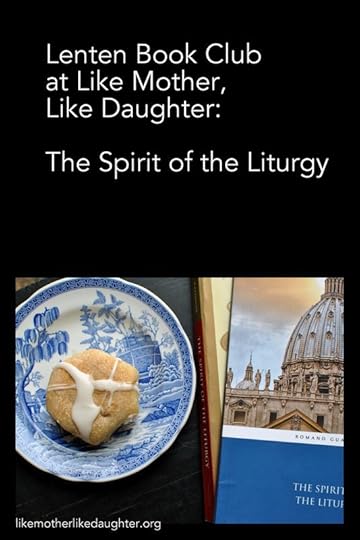
{Lenten Book Club: The Spirit of the Liturgy}
As promised — and I do believe, in keeping with the mission of this blog, which is to talk about what we want to talk about — we will read The Spirit(s) of the Liturgy as a little book club together this Lent. I will post here exactly as I would talk to you about it if we were together. Please add your questions and comments!
First, Romano Guardini’s The Spirit of the Liturgy. It’s free, online. You can also purchase it here, although be warned, this edition does not have the footnotes, which stinks
 .
.Then, Joseph Ratzinger: The Spirit of the Liturgy
 (yes, same name).
(yes, same name).(When you buy something via our Amazon affiliate link, a little cash rolls our way… just a little. Thanks!)
I’ll post on Fridays. I’ll give you your homework, I’ll talk about what we read, we’ll discuss in the comments. You can do this study at any point, but if you want to stay current and join in the convo, that’s how it will go.
*************
Previously:
The Introduction: Escaping Preference
Chapter One: Seeking Universal Prayer
Chapters Three and Four: The Style and Symbolism of the Liturgy
Chapter Five: The Serious Rules of the Sacred Game
Chapter Six: Truth is the Soul of Beauty
Homework: No more homework for this book! A blessed Passiontide and Easter to you all, dear readers; thank you so much for reading along with us. Consider getting your copy of Joseph Ratzinger’s The Spirit of the Liturgy , which builds on the ideas we have studied in a much more linear and specific way. I will have another book club during Eastertide so we can read that.
, which builds on the ideas we have studied in a much more linear and specific way. I will have another book club during Eastertide so we can read that.
Chapter Seven: The Spirit of the Liturgy, Romano Guardini
The Primacy of the Logos over the Ethos
In my humble opinion, if you can understand this chapter and its fundamental distinction between being and doing, you will be able to grapple with all the problems life throws at you.
Seriously, while the chapter on Playfulness was necessary to read in order to go on to the Ratzinger, and was an important precursor to this one, with its investigation of purpose and meaning, this chapter is the one which most excited me and made me want to inflict this admittedly difficult book on you, my dear readers who perhaps would prefer to click on a post about raising children, homeschooling, making dinner, or knitting.
Yet, I believe that internalizing the primacy of the Logos over the Ethos will enable us to enjoy those fun activities more and do better at them, because when life is ordered correctly through the understanding, it has more meaning. The Church refines each temperament to be like that of Christ’s. She infuses Christ’s stillness in the active man and gives Christ’s energy to the sedate man.
We must not make the Liturgy in our own image.
That is what this chapter is about!
You see, there came to be a divide that fell between man and that which is beyond man. We can often feel that philosophy has nothing to do with our everyday lives, yet that is not true. What we think about things really matters. And in the West, many centuries ago, the very greatest thinkers began to doubt that there is a connection between the material world and the immaterial world, or that the immaterial world is even real; and most importantly, that words have meaning connected to what they are — that they are not simply random things we have agreed on.
Doubt fell on man. Doubt that he could ever see the truth… doubt that truth exists apart from what he sees in front of him. And, of course, doubt about God and His existence. Fast forward and this doubt has spawned the most fatal negation of all on earth: the erasure of meaning about the human person, male and female.
It’s hard for us to know what to do about this doubt, or how to approach it. In some ways, we need it — when we are testing theories about things in a scientific way — and indeed it’s the impetus behind the incredible burgeoning of scientific knowledge. But even science (and especially science) must have something behind it — some fundamental anti-doubt — some affirmation of things as good and connected to truth and rightly ordered to truth — or else it devolves to mere laboratory work. Real scientists have testified to the characteristic of receptivity and intuition necessary for their work to take place at all.
And receptivity is the antithesis of doubt.
Guardini speaks right away in this chapter about the restlessness of the person of action. This is a recurring theme of his, and here he goes to the root.
People [who are generously endowed with moral energy and earnestness] regret one thing in the liturgy, that its moral system has few direct relations with everyday life.
Today, now that the “moral” as a category has subsided, relativism having truly gained the upper hand, I think we need to substitute the term “good will,” or “people with benign intentions.” And for “moral system,” I think we need to substitute “plan of action.” It’s simply the case that the ensuing century has neutered morality (the system of identifying good and evil), so that we don’t speak of it any more. Yet the type remains: the person who wants everyone to do something about what they have learned in their religion, and who wants worship itself to be more dynamic.
I’d say that in this new century, this personality has gone beyond mere exhortation, establishing of movements, and urging of devotions* — we now have a full-fledged, entrenched, and all-pervading bureaucracy of programmers — that is, purveyors of programs.
*As Guardini states and repeats in a footnote, devotions are good and necessary, and the life of faith needs them. It’s primacy we’re looking into here.
It’s the rare parish that doesn’t consider itself first and foremost a provider of programming for the faith. The style now is even to cease calling it a church at all, but rather community or center. That which Guardini touches upon here has become a thorough-going way of life, and like its political counterpart, it has its own means of reproduction. Bureaucracies, once established, are notoriously difficult to reform or remove. There is, after all, always another program to administer and another person whose livelihood depends upon doing so. And the more active and sentimental (emotions-based) a person is, the greater their influence when left unchecked.
It’s hard to step back from all the activity and ask some questions, for two reasons. I’ll get to the second towards the end of this discussion. The first is that we’re all rationalists now. The rationalist uses analysis, taking things apart, as a substitute for seeing things whole (in Latin, ratio, discursive reasoning, vs. intellectus, the part of the intellect that sees and receives knowledge effortlessly) — that is, we are all inheritors of this legacy of falling back on activity and will; of living according to Ethos as the highest principle.
I’d say that most of us do have a secret suspicion that we’re better off doing a program about faith than going to Mass; we feel more fulfilled by a lively Bible study than by praying Vespers, should we ever get the chance — or we’d like our liturgy and prayer to be a Bible study. We are convinced that the best remedy for poor preparation for marriage is another, better program for marriage preparation. When we think of religion, we think of catechesis. When we think of passing along the faith to our children, we think of religious education classes.
It’s not that studying the faith or preparing for marriage with a class are bad things. Not at all. They are good things. Yet…
One person commented, when I was describing this new model of the church, and deploring the making of Sunday into another day of busy-ness, of learning and teaching and classes and programs, “Well, what would the church be? Would there just be… the sacraments?”
Well. Hmmm…
Josef Pieper, in his book on Happiness and Contemplation, reminds us of a few things.
The political life (which in an election year is on everyone’s mind even more than usual), according to Aristotle, exists for something beyond itself: for what is not political.
In fact, and this might shock us a little, as again, we are rationalists to some extent, political life is not even for some ideal life of the common good here on earth. No, we take part in the political life to secure peace, that we might have breathing space in order to devote ourselves to contemplation of the good.
Totalitarians, Pieper tells us, will allow “spare time [recreation]. But not true repose.”
Dr. Johnson said, “To be happy at home is the ultimate result of all ambition.” And what is the home? The home is where all work is ordered to the day of worship, that we might contemplate the Good. The home is the least efficient place, which is why those social engineers/busybodies who are always trying to better things attack the home first. If you are aiming at running things more smoothly, something like dormitories and collective nurseries work much better. No, the home, like the Church of which it is a little exemplar, exists for its own sake — allowing the person freedom to come in contact with God. But I digress.
Guardini:
This predominance of the will [Ethos] and of the idea of its value gives the present day its peculiar character. It is the reason for its restless pressing forward, the stringent limiting of its hours of labor, the precipitancy of its enjoyment; hence, too, the worship of success, of strength, of action; hence the striving after power, and generally the exaggerated opinion of the value of time, and the compulsion to exhaust oneself by activity till the end.
The Church, he says, can speak to us in any age, “but it must be pointed out that an extensive, biased, and lasting predominance of the will over knowledge is profoundly at variance with the Catholic spirit.”
If not,
Religion becomes increasingly turned towards the world, and cheerfully secular. It develops more and more into a consecration of temporal human existence in its various aspects, into a sanctification of earthly activity, of vocational labor, of communal and family life, and so on.
In short, a kind of club.
While life’s center of gravity was shifting from the Logos to the Ethos [during this revolution in thought I was telling you about], life itself was growing increasingly unrestrained. Man’s will was required to be responsible for him.
Man becomes God, because only God’s will can ultimately take responsibility.
This presumption is guilty of having put modern man into the position of a blind person groping his way in the dark, because the fundamental force upon which it has based life — the will — is blind. The will can function and produce, but cannot see. From this is derived the restlessness which nowhere finds tranquillity. Nothing is left, nothing stands firm, everything alters, life is in continual flux; it is a constant struggle, search, and wandering.
Catholicism opposes this attitude with all its strength.
This is strong, is it not? All these good things: doing, acting, working for the good, seeking to take responsibility — if they are made primary, then the faith must resist them.
The Church forgives everything more readily than an attack on truth. She knows that if a man falls, but leaves truth unimpaired, he will find his way back again. But if he attacks the vital principle, then the sacred order of life is demolished. Moreover, the Church has constantly viewed with the deepest distrust every ethical conception of truth and of dogma.
This discussion is about the order of good things. Truth and dogma are for themselves. They don’t exist for a purpose, they don’t exist to make us better or to make a good place to live on earth, although devotion to them may have those effects. This “ethical conception” — turning everything into a force for the will, including the truth itself! — is not how the Church ultimately does things.
“Truth is not obliged to give an account of itself.”
And what is Logos, then? In the quote above, Guardini mentions that the will can function but cannot see. Logos, the Greek word for word, relates to man’s faculty of the intellect which sees things whole, all at once: which is contemplation, seeing the Good. Seeing has to do with man’s highest faculty, the intellect; whereas doing relates to the will. The perennial argument, much more intensified in our age, is which of these principles has primacy? Guardini, following Aristotle and Aquinas, is trying to show us that the answer is not the will.
The Logos, of course, is Jesus Christ, the Word of God. Pieper (a student of Guardini) uses the wonderful image of thirst to explain how contemplation is our fulfillment here on earth. He explains that when we thirst, we long for something. And when we drink, we receive that thing — we receive it as a gift, in fact.
A man drinks… and feeling refreshment permeating his body… says, “What a glorious thing is fresh water!” Such a man… has already taken a step toward that “seeing of the beloved object” which is contemplation…
Immediately we Christians think of Jesus by the well, telling the woman that He is the living water. We thirst, and our seeking (so important!) is the will, moving us to the good. But when we are quenched, that is no longer an act of the will. It’s its opposite: the receiving of the gift.
What is our contact with this Logos, now that Jesus is not walking on the earth?
It’s Sunday. It’s worship. It’s the Mass. It’s the Liturgy.
The soul needs that spiritual relaxation in which the convulsions of the will are stilled, the restlessness of struggle quietened, and the shrieking of desire silenced; and that is fundamentally and primarily the act of intention by which thought perceives truth, and the spirit is silent before its splendid majesty.
In the liturgy the Logos has been assigned its fitting precedence over the will.
I said, above, that there are two reasons it’s hard to step back from all the activity, the striving, to take a look at what we are doing to worship.
The first reason was that we are rationalists willy-nilly, just by living in this age. The second is that for the majority of people, worship does not have this character of the stilling of restlessness, of repose, of receptivity to the beauty of truth.
Worship itself has been invaded by the spirit of Ethos. My intention here is simply to observe this, not to rehash all the reasons this is so, as I strongly believe that the rehash is amply achieved elsewhere. No, I want us to get at the root of what the effect of this invasion is, to think about it, to feel it in our bones the way we stop and take stock of the health of our own body.
What I’m trying to say (and it’s really hard!) is that at some point we have to step back from “I thirst!” and wonder why we have such a hard time finding a drink of fresh, clear water. Where is this water?
I’d venture to say that for most of us, worship is not what it ought to be, and it’s not usually in our control to change that; simply because when we try, we are met with the charge of preference, which is what Ethos dwindles into, inexorably. We live in the age of preference. How to return to the Logos? And what then?
The liturgy has something in itself reminiscent of the stars, of their eternally fixed and even course, of their inflexible order, of their profound silence, and of the infinite space in which they are poised. It is only in appearance, however, that the liturgy is so detached and untroubled by the actions and strivings and moral position of men. For in reality it knows that those who live by it will be true and spiritually sound, and at peace to the depths of their being; and that when they leave its sacred confines to enter life they will be men of courage.
Thank you for reading along with me!
Feel free to leave comments at any time — I will always see them.
The post Life’s Center of Gravity ~ The Spirit of the Liturgy: A Lenten Book Club appeared first on Like Mother Like Daughter.
March 17, 2016
{pretty, happy, funny, real} … and Roasted Cauliflower Soup
What is this {pretty, happy, funny, real} you speak of?
~ {pretty, happy, funny, real} ~
Capturing the context of contentment in everyday life ~
Every Thursday, here at Like Mother, Like Daughter!
I think this might be the same tree that led {phfr} last week? I love its baby leaves. I suddenly have an urge to make pom-pom garlands in all sorts of spring colors.
In just one short week, Pippo has become a bike-riding machine. Most of the time he’s about half a block ahead of us on our walks, and he’s just discovered he can loop back and forth instead of just sitting around, waiting for us to catch up. It’s so much fun to watch.
I love that Molly insists on wearing her helmet, too, whether she’s walking or riding in the stroller. It’s more a matter of fashion than caution for her (she’s never met a hat she didn’t like).
Speaking of fashion, and caution, (and ignoring the runny nose, poor girl). Molly was given creative control over the hairstyle shown above — we call this, “All the Pigtails!”
You see the bandaid? This one tripped and fell while climbing on our stepstool, and ended up with a gash in her chin that needed a few stitches. She was very brave, considering the circumstances (aka, being held down while a stranger sewed up her face). The medic (it was at the Army hospital, so he was a strong young soldier, just to give you a sense of his physical capabilities) who was given the task of keeping her head still was sweating and sore by the time the doctor was done. They were suitably impressed by her strength. Poor baby.
Yes, Mom, I wiped out in the mud. This is not a problem.
Can’t stop, won’t stop.
And now for something completely different… a recipe for soup! Not the most spring-like of soups, but meatless, easy, inexpensive, and very tasty! And since there isn’t actually that much time left during Lent, and no one is going to get excited about meatless meals during Eastertide, I’m going to share my newest soup recipe here among the baby photos.
Roasted Cauliflower Soup — Like Mother, Like Daughter
We’ve had this several times, both in this simple form and a curried version. Both are great. It’s as easy as can be, but has a lot of rich, roasted flavor. The first time I made it, pre-Lent, we had crumbled bacon on top and that was, obviously, even more delicious.
First, roast your vegetables:
1 head cauliflower, washed and chopped
1 large onion, chopped
1 head garlic, separated into cloves but not peeled (I go ahead and roast it all, then use some of it in the soup and set the rest aside for putting on pizza or spreading on bread or other deliciousness. If you’re not into that, just do a few cloves — or toss it all into the soup!)
Toss with a few tablespoons of olive oil and salt and pepper to taste. Spread on a roasting pan. For easy cleanup, use parchment paper (or, a silicone baking mat. I use mine all. the. time.). Roast at 400* for 30-40 minutes or until nice and caramelized.
Pick out the garlic cloves, squeeze 4 or so big cloves out of their jackets into the pot, and pop the rest into a container in the fridge for another use. Transfer all the cauliflower and onion into the soup pot. If you want to go the curried route, add 2 teaspoons of your curry powder in with the vegetables. I like to add in some extra garlic powder and coriander as well (maybe 1/2 tsp each?).
Add:
1-2 potatoes, diced. (Optional, but makes it more hearty. We’ve enjoyed it both ways.)
Chicken stock and/or water to generously cover, about 6 cups or more.
Bring to a boil, then lower the heat and simmer 20 minutes or until the potatoes are very tender. (If you’re not using the potatoes, just simmer 10 minutes or so.)
Using an immersion blender, or a regular blender in batches, puree soup until smooth, adding more water or broth if necessary if it’s too thick.
Taste and add salt, if necessary. It’s also nice to finish it off by stirring in 1/2 cup or so of cream or milk here at the end.
Serve with bread and butter, biscuits, corn muffins, grilled or toasted cheese, or your favorite soup-accompaniment.
[image error] Loading InLinkz ...
The post {pretty, happy, funny, real} … and Roasted Cauliflower Soup appeared first on Like Mother Like Daughter.
March 15, 2016
How To Get the Kids Doing Dishes… and Opening Up.
This past weekend I had the great idea to take advantage of the visit of Deirdre and the family to stage a little photo shoot of a sink piled with dishes and topped off with a high chair tray.
It had come to Auntie Leila’s attention that some moms with lots of kids don’t know how to overcome certain difficulties with the chore of doing dishes, and right away I could see the issue…
Needed pictures for a good old-fashioned DON’T.
But I forgot.

In general, I think you can come to some conclusions from my clearly child-less and possibly redolent-of-retirement-living-with-nary-even-a-teenager-around photos.
First, it’s true: I am no longer in the midst of the chaos of bringing up seven children. I am taking advantage of the briefest of windows between mayhem and senility to try to transmit what I alone have survived to tell you. Then grandchildren come and it all flies out of my consciousness!
Second: Clearly even with the hours that stretch between meals and the opportunity to bring my life into streamlined glory, I am still a person with not much storage (in the kitchen — I do have a ginormous house that swallows the detritus of long-gone children without a hiccup — alas and please come rescue me). The upside is that you can see that — even now — I’m not one of those spic-and-span housekeepers with utterly empty counters (how, HOW do they do it??). So you can relate.

So now I am going to tell you two things.
If you want your children to do dishes, you need flow in your kitchen. I already have an excellent post about this, in which I poured out my primest thoughts. It has pictures and diagrams and is a masterpiece of clarity. You should absolutely study it.
Go ahead. Go think about it in terms of your own set-up, whatever that may be. My kitchen is far from perfect! Doesn’t matter!
F L O W — clean – dirty – clean. Don’t forge a new path every night. Make the path once and for all.
Why? Because if you are tempted to run screaming from your life every single night as you face the dishes, just imagine how it looks to a 12-year-old!
No wonder that kid hems and haws and has to psyche himself up. These “recurring problems” — like doing dishes after every meal — have to be subjected to a process, a system, a set of previously thought-out steps.
Okay, are you back?
My new rule for you: Don’t put the baby’s high chair tray on top of the dirty dishes in the sink.
This is what is making your kid die a little every night. It’s what makes the whole job take so long — the piling.
It’s wicked unfair.
Either get the baby out (we call this “deploying the crack-cleanup team” — one to wash him with a warm washcloth, face and arms, and another to wipe down the chair itself — don’t forget a dog to clean the floor) and clean the tray at the sink before the general cleanup begins — this makes sense because usually baby is done before the meal is over — returning the tray to the high chair, everything nicely spiffy…
or leave the tray at the high chair until the general cleanup is over, doing it last. Just shove the whole thing to the side. But don’t forget it, ew.
But do not put it in the flow. It’s too big! Look! It doesn’t fit in the sink! Even without a photo of a believable post-prandial mess! (And this tray is smaller than most.)

Get this kind of soap dispenser:

I have had this for 30 years. Why do I love it? Because it’s heavy and doesn’t tip over easily. Because when it does tip over, it doesn’t break — it’s heavy pottery. Because I can get soap out without picking up the bottle with my other hand. Because I can replace the pump with one from any bathroom soap dispenser (which then has to be sort of cemented in, which you can see there that we’ve done, maybe a little messily).
Where do you get it? I don’t know… my neighbors got it for me as a souvenir from their Alaska cruise (random but very appreciated!). Do you make pottery? Make us some of these!! Just pay attention to the size of the top.
A lot of us would really like the kid doing the chore to… use… dish soap.
But it’s hard to figure out how to do it as you are in the throes of washing when you need both hands.
Another thing: Figure out where you will stage things.

You can’t handle a sink full of dirty dishes and neither can a kid. You need a place where you will put away food (that’s someone else’s chore, by the way!) and stack things so that they are scraped and ready for the dishwasher or soapy basin.
Know how to do dishes and then teach your child how to do them. Don’t just burden him with a problem that you yourself can’t solve.
All this is explained in that post! Go read it! Read it before you comment, because all the details are there!

But now I have something else to tell you about this chore, something that my friend Therese was telling me the other day. Something that also addresses that vexing issue of how you are dying to go to bed but somehow, for some reason, your older kids can only bring themselves to talk to you after 10 pm.
Suddenly the deep dark concerns come out… so late… so desperately late…
Well, Therese was telling me how her mother (of 8 children) always “helped” whichever kid it was who was doing the dishes. She didn’t want to have a dishwasher (machine) because she knew that it was during that time that the conversations would happen.
She remembers one sister or another saying, “Therese, I’ll do the dishes with Mom tonight.” And that was so they could talk.
You don’t have to get rid of your dishwasher, but do realize that much of the time, not only do you need to be in there to be directing flow, putting away food (so that you can put it to best use later as a good manager), and overseeing this not exactly easy chore — you will also have a chance to have a little conversation with your child.
Yes, that moment after supper is sometimes when baby needs to nurse, and you can send in an older child or Dad to take your place in the kitchen. But as you get good at this game we call parenting, you can also use the time when others are clearing up to nurse the baby and then hand him off to another child for play or bath… just at the opportune time to be there for the kid who needs you by yourself.
Some nights, it’s not deep consultation, but just singing songs, and suddenly you’ll have a lot of help! And even if the kid is there by himself, it’s okay because it’s a doable chore. It’s not the aloneness that is terrible, it’s the impossibility of the thing. Which you are now mitigating.
That’s family life together. The very things that seem like the worst drudgery create the best memories — when there is someone loving who will put thought into how it will go.

The post How To Get the Kids Doing Dishes… and Opening Up. appeared first on Like Mother Like Daughter.
March 12, 2016
{bits & pieces}
The weekly “little of this, like of that” feature here at Like Mother, Like Daughter!
What we’re currently reading from the library:
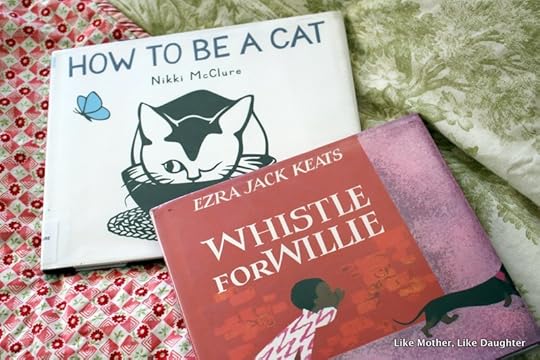
How to Be a Cat by Nikki McClure — this is, essentially, a collection of lovely woodcut illustrations describing cats’ activities. Not only is it visually beautiful, it turns out that it’s handy for the occasion when you’re nursing the baby in the rocker but your toddler wants you to read to her: she can set it on the floor and turn the pages, and you can read the jumbo words for her even from a little distance!
A Whistle For Willie by Ezra Jack Keats — This book struck me as pleasing at first, but I wasn’t necessarily blown away by it. But Finnabee’s intense interest in it was a hint to me that I should give it some thought and bring it home for further reading. After a few times through, I discovered that I am as much a fan as she is. For her, it is a fun and satisfying little story about a boy learning to whistle so that he can summon his dog. For me, it is a reminder that children need time, space, and even boredom in order to be kids. I know that I need input like this all the time in order to combat the pressures of contemporary American parenting (“Don’t stop interacting with your child! Always have activities planned! Safety first – never let him out of your sight!”) The little boy, Peter, is blissfully free to figure something out on his own — and my two-and-a-half-year-old clearly loves it.
(When you buy anything on Amazon using our links, we get a small commission. Thanks!)
This week’s links!
Sacred Music:
Propers of the Mass Versus the Four-Hymn Sandwich – When you have the chance for a longer article, do sit down with this one and receive a great introduction to basics of Sacred Music, including historical context and liturgical information. Perhaps you know vaguely about “something to do with we really should have more chant” or “we’re not really supposed to be just singing these songs”… this piece will fill you in even if you have no prior education in the matter. Auntie Leila says that we will be revisiting this topic and we invite comments from our liturgical music friends.
The Renaissance of the Mass Propers – for further reading on the topic of the link above.
Literature:
Speaking of library books: big news for children’s literature — A newly discovered Beatrix Potter tale!! The Kitty In Boots story is set to be published this fall! My mom passed this along to me and expressed ambivalence about the choice of illustrator; frankly, it’s a huge disappointment to me. I think that Quentin Blake works for Roald Dahl, but I wish someone else had attempted this with more of a tribute to Potter’s style.
Pippin’s Pain, Providence, and Plotlines
Miscellany:
Mothers and Martyrs – a reflection on the saints Felicity and Perpetua from the Dominicana Blog. Rosie sent this along with the following: I don’t think I realized that Perpetua and Felicity (feast day was Monday) were mothers (nursing and pregnant, respectively, when arrested!), but I love them all the more for having read this reflection on them, motherhood, and martyrdom. Spoiler: “The martyrdom of these women, then, can be seen as a consummation of their maternity and their discipleship. The daily sufferings and sacrifices of mothers, biological, adoptive, and spiritual, are the steps by which they trample the head of Satan and climb the rungs of the ladder to Heaven.”
It’s Not You. Bad Doors are Everywhere. (Warning: some language [some bleeped but some not].)
From the Archives – Easter-prep edition:
Dear Auntie Leila: I don’t know what to do for Easter
Thinking about Holy Thursday, Good Friday, and Easter Sunday
~We’d like to be clear that, when we direct you to a site via one of our links, we’re not necessarily endorsing the whole site, but rather just referring you to the individual post in question (unless we state otherwise).~
Follow us on Twitter.
Like us on Facebook.
Auntie Leila’s Pinterest.
Rosie’s Pinterest.
Sukie’s Pinterest.
Deirdre’s Pinterest.
Habou’s Pinterest.
Bridget’s Pinterest.
Habou’s Blog: Corner Art Studio.
Auntie Leila’s Ravelry.
Auntie Leila’s Instagram.
Rosie’s Instagram.
Sukie’s Instagram.
Bridget’s Instagram.
The post {bits & pieces} appeared first on Like Mother Like Daughter.
March 11, 2016
Truth is the Soul of Beauty ~ The Spirit of the Liturgy: A Lenten Book Club

{Lenten Book Club: The Spirit of the Liturgy}
As promised — and I do believe, in keeping with the mission of this blog, which is to talk about what we want to talk about — we will read The Spirit(s) of the Liturgy as a little book club together this Lent. I will post here exactly as I would talk to you about it if we were together. Please add your questions and comments!
First, Romano Guardini’s The Spirit of the Liturgy. It’s free, online. You can also purchase it here, although be warned, this edition does not have the footnotes, which stinks
 .
.Then, Joseph Ratzinger: The Spirit of the Liturgy
 (yes, same name).
(yes, same name).(When you buy something via our Amazon affiliate link, a little cash rolls our way… just a little. Thanks!)
I’ll post on Fridays. I’ll give you your homework, I’ll talk about what we read, we’ll discuss in the comments. You can do this study at any point, but if you want to stay current and join in the convo, that’s how it will go.
*************
Previously:
The Introduction: Escaping Preference
Chapter One: Seeking Universal Prayer
Chapters Three and Four: The Style and Symbolism of the Liturgy
Chapter Five: The Serious Rules of the Sacred Game
Homework: Read Chapter Seven, the Last, for next week.
Chapter Six: The Spirit of the Liturgy, Romano Guardini
The Seriousness of the Liturgy
(I feel the need to remind you that I’m only pulling out a few strands here, and trying to summarize. Feel free to bring up other passages in the comments — it’s all so fruitful for thought and discussion! Thanks for reading with me!)
In this chapter, we have to be careful to consider the cultural state in which Guardini is writing. The temptation will be to imagine that he is reacting to a situation which he, in fact, did not experience (although he may have foreseen it), namely, the total collapse of the arts in the post-modern world, with the disaster that this has meant for the Liturgy. And we might fall into the error of thinking that he is, in effect, saying, “Ah, don’t worry about it” — “it” being, in short, bad art in the Liturgy.
If we don’t remember how things were (and how can we? We are too young! But we will try), we will mistake his meaning.
He has in mind the previous generation (as one always does), which was, in Europe especially, living out the very last gasp of the Renaissance mindset, which was to look upon beauty and art as simply aestheticism. At that point, having exhausted all the rapturous and exuberant explorations of the form, art had become something incompatible with worship, namely, it had devolved to a means of arousing emotions. (Today, if you ask someone what music is, he will answer, “an emotional experience.” Which is not what it is, although it may be an effect that music has, to rouse the emotions.)
In the previous chapter, Guardini wanted us to consider the Liturgy as a work of art, sharing in the philosophical idea of playfulness; that is, full of meaning and existing for its own sake rather than for the sake of something else.
Here, he brings us up short, lest we fall into this error of savoring the art — play — merely for itself as a diversion; even though it does exist for its own sake!
To explain the paradox, he offers a sharp reminder that it does art itself “an injustice” to fail to uphold the truth into which art is a window: he invokes the image of “the careworn man who seeks nothing at Mass but the fulfillment of the service which he owes to his God; the busy woman, who comes to be a little lightened of her burden; the many people who, barren of feeling and perceiving nothing of the beauty and splendor of word and sound which surrounds them, but merely seek strength for their daily toil” — reminding us that “all these penetrate far more deeply into the essence of the liturgy than does the connoisseur who is busy savoring the contrast between the austere beauty of a Preface and the melodiousness of a Gradual.”
Again, he is not resorting to that tired excuse used to turn aside or rebuke the genuine desire to adorn the Liturgy with what is fitting to its essence. Remember, he knows not of what has ensued. He is, rather, giving a quick primer on the relation of beauty to reality, and that is not an easy task.
Beauty is to the contemplative side of the Church what power is to her active side.
The preceding chapter endeavored to demonstrate that artistic self-sufficiency is actually compatible with the liturgy. Only a sophist could argue that the justification of a form of life resides exclusively in its manifest purposes. On the other hand, one must not forget as well that artistic worth — beauty — is as dangerous to the susceptible person as is power in the corresponding sphere of active communal life.
Just previously, he had stated: “But if power, the servant, were to be promoted to the position of master, the means to that of the end, the tool to that of the guiding hand, religion would then be stifled by despotism and its consequence, slavery.”
Likewise with beauty!
What beauty is, however, proves to be one of the more difficult philosophical questions, yet of the utmost importance to pursue, if we are to put it in right relation to other principles, and most of all, to escape preference, the goal of this whole study.
As Guardini says, beauty is a given — one of those objective qualities that must be accepted as axiomatic.
Truth is of itself a value, because it is truth, justice [goodness] because it is justice, and beauty because and in so far as it is beauty. No one of these qualities can derive its validity from another, but only from itself. The most profound and true thought does not make a work beautiful, and the best intentions of the artist avail as little, if his creation, in addition to a concrete, vivid and robust form, has not — in a word — beauty. Beauty as such is valid of itself, entirely independent of truth and other values…
… Beauty is the full, clear and inevitable expression of the inner truth in the external manifestation. “Pulchritudo est splendor veritatis” — “est species boni,” says ancient philosophy, “beauty is the splendid perfection which dwells in the revelation of essential truth and goodness.”
Where we stand now, this discussion is actually of supreme and vital importance.
It’s really worth trying to figure out what he is saying. The ancients said things like “beauty is the radiance of truth” and we sort of nod and shrug… but when we consider the Liturgy, we suddenly see that God and the things of God are good (what Guardini here is calling just) — we know that God is true — but we also know that we can’t know and receive this goodness and truth without light to see them by.
And then it dawns on us that God has made us with senses; we are human beings, connected by nature to the material world, and with a spirit, connected to the immaterial world. What is the connection of these connections? What is the light, the radiance?
Beauty .
And that dawning becomes the realization that beauty, far from being a nice little dollop of frosting on a cake (or maybe sugar to make the medicine go down), is precisely the means by which we can apprehend goodness and truth.
That is how the Western mind has expressed it. In the East, the simple way of putting it has been to say, “Beauty is a window on the unseen world.” (Knowing this helps us to understand icons better — we in the West who are so used to thinking of art as a merely aesthetic experience or as a tool to accomplish a goal.)
This is why Guardini insists that “truth is the soul of beauty” and that we not fall into the error of mere connoisseurship in the guise of honoring the Liturgy, or rather that in honoring the Liturgy, we honor the truth of it and trust that the art will follow.
… [T]ruth is at stake, and the fate of the soul, and real–yes, ultimately the only real–life. All this it is which must be revealed, expressed, sought after, found, and imparted by every possible means and method; and when this is accomplished, lo! it is turned into beauty.*
What makes us almost incapable today of understanding this in a deep way can be summed up in one word:
Rationalism.
We will speak of this again. For now, know that a serious breach occurred in man’s thinking, and we turned away from knowledge of objective reality (and, ultimately, God) towards doubt. Rationalism refuses to accept reality as a gift, to receive truth from outside of itself.
When this breach happened, art was demoted inevitably from a window onto reality to an opaque wall, beyond which we don’t even dare to look — lest we find nothingness.
Art, the expression of beauty, while (in Guardini’s time yet) retaining many characteristics of the splendor of truth (harmony, graciousness, color, and simply good technique), having left aside its duty to truth — and indeed, despaired of the hope of knowing the truth, entered willy-nilly the sphere of the Will. Where there is no contact with something outside of oneself, only one’s feelings — one’s sense of power or lack of power — are left.
Soon (after Guardini’s time, but in Ratzinger’s and ours, so we will revisit this), even the vestiges of splendor in art fell away, and all that was left was the Will — the use of power to convey the desired effect. And that is why art today (as a larger cultural phenomenon, not speaking of exceptions) is ugly and seeks merely elicit reactions or to convey emptiness. Let’s repeat what he said above:
The most profound and true thought does not make a work beautiful!
Far less a banal or untrue thought!
Thus the warning:
People who have not enjoyed… human perfection** or the beauty of a work of art, but desire closer familiarity with it, must take the inner essence for their starting-point.
This admonition can be applied to those whose facility with the technique of art enables them to produce all sorts of fabulous creations as well as those who consider that a mere gesture or chord — or dissonance — constitutes a work of art.
It turns out, therefore, that the gaudiest and most sentimental Rococo or Romantic works have more in common with today’s vapid, ugly, and formulaic compositions than we might think.
In fact, they are two sides of the rationalist coin: The two things that can happen, once you give up on knowing truth.
On the one side, you have art for art’s sake, aestheticism. On the other, art as manipulation, targeted to arouse what are deemed appropriate emotions — a delivery system, and who cares about the packaging? It’s well known that certain musical chords can produce certain feelings. But is it beautiful merely to produce feelings?
Maybe this observation relieves the anxiety we feel (I know I felt it) when considering Guardini’s “careworn man” or “busy woman,” just because it’s been used against us when we’ve tried to defend beauty, as a tacit recourse to preference. But Guardini affirms: yes, perhaps they “know nothing” of beauty — not consciously. Yet, surely they know, or can sense at some level, what is fitting and what is not — for we are they — and we know! And they seek repose and find it where beauty radiates the splendor of goodness and truth, in that restrained fashion that we have been reading about in previous chapters — that serene correspondence with what is unseen, which allows room for their souls to expand and rest in the Living God.
*Guardini’s footnote:
The Abbot of Marialaach rightly remarks in this connection, “I stress the point that the liturgy has developed into a work of art, it was not deliberately formed as such by the Church. The liturgy bore within itself so much of the seed of beauty that it was of itself bound to flower ultimately. But the internal principle which controlled the form of that flowering was the essence of Christianity.” (Herwegen, “Das Kunstprinzip der Liturgie,”p. 18, Paderborn, 1916.)
** Consider: “human perfection” means holiness. A little glimpse into another earth-shaking thought: Holiness and Beauty are the two ways (as Ratzinger tells us elsewhere) that man can encounter God on earth. The saints and art are the means that the material world can deliver goodness to us by our senses. Jesus Christ is the Exemplar: the Holy One, Beauty Itself, uniting in Himself the material and the spiritual — Human and Divine — perfectly in Himself. His saints carry out His mission… as do His artists. Both must do what Guardini tells us at the end of this chapter:
On the whole, however, and as far as everyday life is concerned, this precept holds good, “Seek first the kingdom of God and His justice, and all else shall be added to you” — all else, even the glorious experience of beauty.
The post Truth is the Soul of Beauty ~ The Spirit of the Liturgy: A Lenten Book Club appeared first on Like Mother Like Daughter.
March 10, 2016
{pretty, happy, funny, real}
What is this {pretty, happy, funny, real} you speak of?
~ {pretty, happy, funny, real} ~
Capturing the context of contentment in everyday life ~
Every Thursday, here at Like Mother, Like Daughter!
I’ve been trying to make it to daily Mass more often during Lent which, practically speaking, means going the one morning per week that it’s a little later than usual since the closest church is 20 minutes away and we are not particularly efficient at getting out the door in the morning. But we’ve made it one day each week so far, which has been great.
By which, of course, I mean it’s been a mad rush to get everyone fed, dressed, and out the door vaguely in time, being thankful each week that our priest runs a little late too, and relying on our wonderfully kind fellow parishioners to forgive the squirms, noisy whispers (“are we DONE, Mom?”), and whatever other antics we come up with. We’re trying.
Last week, someone or other was being squirrelly during the reading, so that I wasn’t able to fully turn my attention to it until what turned out to be the very end, so that literally the only words I heard and internalized were,
“…your children and your children’s children. The Word of the Lord.”
I honestly have no idea what the rest of the reading was about, but if ever there were a hilariously vocation-affirming half-second of Scripture to hear at that moment, that was it.
Thanks be to God.
We have been spending as much time as possible outside lately while the weather is cooperating (by which I mean, it’s gorgeous now without being hot, and the wasps aren’t out yet!). We’ve started our seeds in the big planter outside our back window, and they each have their own side of the planter where they planted a row each of peas and carrots. I’m glad we did it that way, since Molly has dug up half her peas to check on them, and tried to plant more seeds on top of the rest, so if her gardening techniques prove to be a little overzealous, they at least hopefully won’t doom her brother’s efforts as well.
Since we didn’t have room for all the seeds, I told them they could plant the rest anywhere they liked, so long as they weren’t disturbing the ones we’d already put in, and they weren’t digging holes in the grass. So now they have their own little garden behind the shed, which they are allowed to water using their buckets.
This takes many trips. It’s great.
Eleanor is a full-fledged walker now (toddler? Ack!), which is perfect timing, since she puts ev.ery.thing. in her mouth. Before she could walk, that meant every time I tried to put her down outside, she’d spend her whole time trying to eat every leaf, stick, and clump of dirt within reach. Now, she is able to scout around for the very best leaves and sticks that the yard has to offer — or even (be still her heart!) get her hands on some sidewalk chalk!
As you can see, she has lost no time figuring out how to play every game the big kids play. She does not appreciate being left out.
Speaking of babies growing up… Capt. P got home from work early after many long days in a row and decided to push Pippo down the little hill in our yard. Worked like a charm.
One last little bit of {real} for you: some time ago — months? a year? more? — the doorknob to our pantry/laundry room broke. The latch itself was broken, and rather than risk a child getting stuck in there, we just took the knob off entirely. Not a big deal, since it’s not a door that really has to latch; we’d just swing it shut when we needed to hide the small mountain of clean laundry or messy shelves. Besides, that’s the doorway where we hang the baby jumper (hence the chipped paint at exuberant baby height), and you can’t close a door with a jumper in it anyway.
I knew it wouldn’t be a big deal to replace it, except that I got it into my head that we actually had to replace all the doorknobs in the house (that sounds drastic, but actually there are only 11), since they all were of the cheap, brassy variety, and a few others were on their last legs as well. So of course I wasn’t going to buy a new one to match these.
Maybe you don’t have a hard time committing to things like this. It took me, as I mentioned, quite a while.
And like I said, it wasn’t a big deal. In fact, I don’t think we even noticed anymore that there was anything unusual about having a raw hole in the door. Just push it open, swing it mostly shut, peek through, totally normal.
But lately, as Nora has been getting more and more mobile, that open pantry has started to be a real problem, and as I fished her out of the tin foil and canned goods again and again, I found myself thinking… “If only there were a way to keep erect a barrier to keep her out of here. Or perhaps some sort of device to hold this door shut. If only we had access to such technology…”
Behold: the doorknob.
[image error] Loading InLinkz ...
The post {pretty, happy, funny, real} appeared first on Like Mother Like Daughter.
March 8, 2016
In which I attempt a casual dinner for friends ~ Tarte de Soleil

We invited friends to dinner, and I tried to keep it simple.
But I also was on fire to make another Tarte de Soleil (I had made one for New Year’s Eve, but who can truly delve into a thing like that with dozens of guests and a table groaning with their fabulous offerings as well?).
And no matter how you slice it, Tarte de Soleil is not going to be all that casual. But it had to be done!

I had seen this flakey hors d’oeuvre of awesomeness on Smitten Kitchen, and as I told you on Instagram, was ready to go for it — but lacking Manhattan’s endless supply of, well, everything, knew right away that I had to make my own puff pastry.
People, that Pepperidge Farm stuff looks good but is not worth it. Since it’s made with oil, not butter, it’s going to taste like nothing at all. And while we want to wow everyone with dazzling looks, ultimately, taste better be up there, or how disappointed will we be?

Before I get started on the method here, I will give you the menu. It’s casual in that there aren’t a million dishes (which is how I usually tend to go) and it could all — ALL! — be done ahead of time: not my usual MO.
Since these friends are that delightful kind who will be keeping us wrapped in brilliant, deep conversation from the get-go (no ice-breaking needed! That’s what I love about good friends! What a blessing!), I didn’t want to be tied up out in the kitchen, but ready to go with the food.
The menu:
House Cocktails* ~ The Chief’s department
Chardonnay
Tarte de Soleil and Feta Dipping Sauce
Butternut Squash Lasagna with Italian Sausage**
Kale and Lettuce Salad with Red Onion, Vinaigrette Dressing (homemade)
Homemade Country Bread (from my freezer stash)
Some kind of excellent red wine I’m not remembering, need to ask Habou, and also a nice dry white
Toothsome Brownie Heart Cake with Chocolate Glaze (it was the “vigil of Valentine’s Day” in my defense)***
Ice Cream (not homemade — so casual!)
Tea, Coffee

*We are of the opinion that a cocktail made just for the occasion is delightful. We had our “Bee Sting” aka “Colony Collapse” special, which is bourbon, honey syrup, lime, and ginger ale — as well as a “Cuban Mojito” in honor of the Pope’s visit to Mexico and Cuba. This is a mojito made with tequila. (Note to self, no.)
** I use Alexandra’s recipe, with these tweaks: I don’t bother straining the (minced) garlic and sage, but leave them right in the sauce — why not? I used regular lasagna noodles and lots of sauce, but the squash was separate, as mine was already cooked (it’s my own harvest and I had roasted and stashed lots away — it’s all basically reduced and pureed at that point). And I do fry up Italian sausage and pop that over the squash as well. (So, noodles, squash, sausage, sauce, cheese, repeat.) Excellent and can be made the morning of. Just pop it into the oven as the guests arrive.
*** My brownie recipe (un-salted-caramel version) is tried-and-true and quick, as is the chocolate glaze. Again, can all be made the day before.
Okay, on to this tarte. You can do this if you are used to making pie crust — just make it with all butter this time (usually I do a little lard, but all butter is better for the puff pastry, because butter contains a little moisture that steams up as it cooks, providing the little lift in the dough, making it even flakier).

I used the Julia Child The Way to Cook method for rough puff pastry. It’s so simple (and casual!) — after your pie crust is chilled, roll it out, dot with some more butter, fold it in thirds, roll, chill. Do this again, then do it again without the butter, twice. Voila! As long as the butter is staying chilled, you don’t need long rests between the steps. (I did this all the day before, assembling the tarte in the morning.)
method for rough puff pastry. It’s so simple (and casual!) — after your pie crust is chilled, roll it out, dot with some more butter, fold it in thirds, roll, chill. Do this again, then do it again without the butter, twice. Voila! As long as the butter is staying chilled, you don’t need long rests between the steps. (I did this all the day before, assembling the tarte in the morning.)

My filling was a tapenade with some sun dried tomatoes and dried basil — both from my garden, which made me happy.

The twisting looks incredibly demanding of high skills, but it’s actually not!
You really only have to pay attention to the cutting of the “rays” — here’s how: put a small glass in the center to make a circle shape on the dough. Cut lines that cut the pastry in half (but don’t go through the circle). Then do the same to make quarters. Then do the same to make eighths. Each time, cut opposite to where you cut before — don’t cut by going around. That way, you will keep things balanced. Also, rotate the pan. Now do sixteenths, and then thirty-seconds.
Now twist each ray three times. Don’t worry, it’s easy.


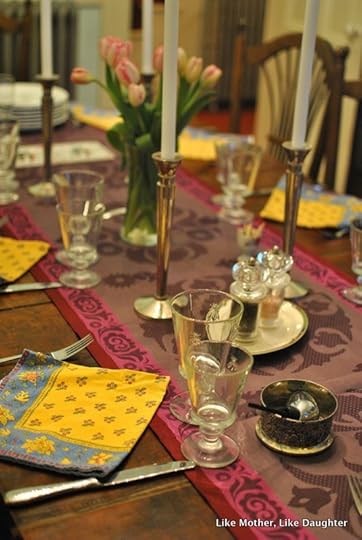

I’m glad I have this tin tray — otherwise I would not really have anything to serve the tarte on. On New Year’s Eve, I put it on a cake pedestal, but that’s not casual at all! When you are making this, think ahead to what you will serve it on. If you don’t have a large tray, think about making two small ones and put them on pretty plates instead.

Tarte de Soleil ~ Like Mother, Like Daughter
Rough Puff Pastry:
Pâte Brisée (you can find Julia’s recipe here, but use all butter, and double the recipe!)
4 Tbsp butter
Chill the Pâte Brisée. Roll it out into a small rectangle, dot with half the (softened) butter, two-thirds of the surface. Fold in thirds by folding the bare section up 1/3 of the way, then fold again. Roll lightly into a small rectangle, chill for 45 minutes. Do this once more with the rest of the butter, then twice more with no butter, chilling if necessary. Don’t worry, it will come out very delish and flakey. You can do this ages ahead of time, even freezing the dough, well wrapped.
Filling:
1/2 cup sun dried tomatoes
1/3 cup pitted kalamata olives (you can also use those lovely large green ones, or a mixture)
1/2 cup chopped artichoke hearts (from a can or jar, drained well) [I’m editing to add this — I just remembered that I put these in there too!]
2 Tbsps pickled capers
1 teaspoon dried basil
1 large garlic clove, peeled
2 tablespoons olive oil or as much as you need to bind everything together, but not so much that it’s at all drippy
Process this all in your food processor, or chop finely. You want sort of a paste, but honestly, if you can spread it, all will be well. Again, this can be made long ahead of time.
1 egg, lightly beaten, for a wash over all when it’s assembled.
Divide your dough in half. Roll one piece thinly, until it’s a bit larger than the size you want your finished tarte to be. (If you are doing two small ones, divide into fourths).
This is important: Cut your circle out of the dough — do not shape your dough into a circle! Why? Because if you want the edges to puff up uniformly, you need to not have folds (remember all that folding?) on the edges. Can you picture this? You need the edges to be “free.” You can form all your scraps (trying to keep them layered, rather than balling them up) into another batch of dough, freeze it, and pull it out another day for puff pastry treats. (Julia has many suggestions.)
Place your circle of dough on your pan (I use a 16″ pizza pan). Spread your filling almost to the edges, leaving about a scant inch. Moisten the bare rim with the egg wash. Roll out the other piece of dough and place it on top. Press the edges together lightly.
Now do your cutting of “rays” as described above, using a small glass to mark a center and cutting with a sharp knife into 32 spokes. Twist each spoke three times. Brush the egg over all.
Bake at 375° (0r 400° if your oven runs cool — you need good heat to get that butter to boil up and flake up your dough) for 30 minutes, rotate it, reduce the heat a little if you need to (that is, if it’s browning on top/on the edges too fast), and bake for 5 or 10 minutes more, until it’s all very flakey and nicely browned all the way down the sides of each ray — a mistake that would be easy to make would be to take it out before all the pastry is cooked through.
People can twist off pieces with their fingers, or you can provide little tongs.
Not necessary, but very nice:
Feta dip or spread:
6 ounces feta cheese, crumbled
4 Tbsps greek yogurt or thick organic yogurt, plain
1/3 cup olive oil
2 tablespoons lemon juice
Mix all together, adding water if it needs to be thinner. Taste for salt (it’s unlikely it needs any) and grind a little black pepper in there.
The post In which I attempt a casual dinner for friends ~ Tarte de Soleil appeared first on Like Mother Like Daughter.
March 5, 2016
{bits & pieces}
The weekly “little of this, like of that” feature here at Like Mother, Like Daughter!

This is the only kind of herbal tea I actually like: hibiscus flower tea, also called kerkaday in Arabic and Jamaica by Latinos. Have you ever had it? It’s most refreshing and very good for you. Egyptians like it with a little lime squeezed in it. It has one million vitamin Cs in it. #Science.
Links!
If you are reading along with us this Lent, I hope you enjoyed this week’s discussion about play. If you are hungry for more, may I suggest this excellent and engaging entry by Fr. James Schall (comprising two essays: On the Meaning of Sport and What Say You of the Peacock’s Tail?). I think it will help illuminate the doing/being problem.
Maybe Shakespeare will be punnier after you read this? (He was super rude, apparently — more than we thought! Yikes.)
If you are in the market for a 12 passenger van, you need to read this, and it’s amusing even if you are not.
Did you know that there are four Marian hymns/chants for each season, to be sung after night prayers? This season (from Candlemas to Holy Week) the chant is Ave Regina Caelorum. It’s a simple tune and the words are so beautiful and serene. You can read about it and find the translation here. I bet your children learn it before you do!
(Something to point out to them about the way the monks sing: it’s very calm and relaxed without being lame; they sing with emphasis, the way you would speak, voice rising and falling; at the end of each phrase, the voice lets up a bit; the tone is never forced. Listen carefully for how they do it — it’s quite different from metrical singing that we usually do. Here’s a little primer on chant notation.)
I really enjoyed this post from Melissa Wiley. Good suggestions for things to spend your money on instead of curriculum. I love her choices, but– actually, get the stereo microscope I mention in this post (the link is towards the bottom), and for the reasons I suggest.
We had two {bits & pieces} featuring encomia of the late, lamented, mourned, Antonin Scalia. With due reverence, I’d like to direct you to this respectful and pointed critique of his jurisprudential theory. While Scalia’s strict “originalist” reading of the Constitution was a necessary corrective to the corrosive effects of the Court’s tendency to make law out of thin air or emanations of penumbrae, it lacked that vital connection to natural law and to the God of all law. “Who will undo the injustice, which at times we inflict by law upon ourselves? Increasingly we are becoming a nation lacking judgment. Who will decide aright for this land’s afflicted?” asks author Anthony Giambrone.
An aside: Do you know that to this day, the inscription over the door of City Hall in Cambridge, Massachusetts (ground zero for secular atheism) reads:
God has given Commandments unto Men. From these Commandments Men have framed Laws by which to be governed. It is honorable and praiseworthy to faithfully serve the people by helping to administer these Laws. If the Laws are not enforced, the People are not well governed.
Today is the Feast of St. John of the Cross.
~We’d like to be clear that, when we direct you to a site via one of our links, we’re not necessarily endorsing the whole site, but rather just referring you to the individual post in question (unless we state otherwise).~
Follow us on Twitter.
Like us on Facebook.
Auntie Leila’s Pinterest.
Rosie’s Pinterest.
Sukie’s Pinterest.
Deirdre’s Pinterest.
Habou’s Pinterest.
Bridget’s Pinterest.
Habou’s Blog: Corner Art Studio.
Auntie Leila’s Ravelry.
Auntie Leila’s Instagram.
Rosie’s Instagram.
Sukie’s Instagram.
Bridget’s Instagram.
The post {bits & pieces} appeared first on Like Mother Like Daughter.
March 4, 2016
The Serious Rules of the Sacred Game ~ The Spirit of the Liturgy: A Lenten Book Club

{Lenten Book Club: The Spirit of the Liturgy}
As promised — and I do believe, in keeping with the mission of this blog, which is to talk about what we want to talk about — we will read The Spirit(s) of the Liturgy as a little book club together this Lent. I will post here exactly as I would talk to you about it if we were together. Please add your questions and comments!
First, Romano Guardini’s The Spirit of the Liturgy. It’s free, online. You can also purchase it here, although be warned, this edition does not have the footnotes, which stinks
 .
.Then, Joseph Ratzinger: The Spirit of the Liturgy
 (yes, same name).
(yes, same name).(When you buy something via our Amazon affiliate link, a little cash rolls our way… just a little. Thanks!)
I’ll post on Fridays. I’ll give you your homework, I’ll talk about what we read, we’ll discuss in the comments. You can do this study at any point, but if you want to stay current and join in the convo, that’s how it will go.
*************
Previously:
The Introduction: Escaping Preference
Chapter One: Seeking Universal Prayer
Chapters Three and Four: The Style and Symbolism of the Liturgy
Homework: Read Chapter Six for next Friday — it’s a short one (ha! I keep saying that) and we can also recap any lingering questions before tackling the big Logos chapter coming up — super exciting!
Chapter Five: The Spirit of the Liturgy, Romano Guardini
The Playfulness of the Liturgy
A couple of notes before we start:
I really wanted to read Joseph Ratzinger’s Spirit of the Liturgy here on the blog (and so we shall, probably during Easter and beyond!). After reading with a group of friends, I realized that right off the bat, there was a reference, the opacity of which was going to thwart understanding unless we read this book (and chapter) first.
Originally, I thought that I just needed the reference — to this playfulness, which seems so odd — and that would be that. But when I read the whole of this Guardini book, I realized, no, we just had to read this one too.
Thus, the quixotic adventure of reading not one but two books on liturgy, right here on a blog where you can also find out exactly how to clean your cast iron pans and plan a nice wedding reception.
So remember this chapter when the day comes that we crack open Ratzinger’s tome.
Also — this chapter could certainly be read with great profit simply to gain insight into childhood and the meaning of play. By extension, one could derive immense wisdom from contemplating the beauty of the vocation that allows children to be children. I wouldn’t discourage you from reading it all over again just to meditate on what play is in this context, apart from the philosophical importance we will observe.
A final point: you may not have the first footnote if you aren’t reading online. In it, Guardini pleads: “In what follows the writer must beg the reader not to weigh isolated words and phrases. The matter under consideration is vague and intangible, and not easy to put into words. The writer can only be sure of not being misunderstood if the reader considers the chapter and the general train of thought as a whole.”

A river runs through my little town, with many little branches meandering off of it. Hence, the roads feature many little bridges. The town isn’t fancy at all, although it is very old. It does have its share of old oaks, Colonial houses, and quaint town center with historic church. I don’t mean to romanticize it; it’s modest by New England standards — it’s no Concord or Lincoln. Here you will find just an old garrison erected against the Indians (who did prevail for a time, but that’s another story).
Anyway, you can imagine that these bridges cost the town a lot to build and maintain. They have a purpose, which is to enable travelers to get from one part of the town to the other. But they also have meaning apart from that purpose, because they define our place in a way, giving it what would be termed character; but which really means its essence, not really planned, exactly, but just arising out of what is given.
Surely the materials used to build the bridges also arose out of an intersection of need, budget, and availability. I’ve thought about these bridges a lot, and I don’t think that anyone put a huge amount of effort into making them beautiful (I could be wrong — they could represent the very best that the available bridge architects could muster, but I don’t think so — I think they are more workmanlike than that), yet they do have a charming quality. And they are not particularly old, most of them. They get the job done (getting you from one side of the water to the other), but not without contributing, in their way, to an overall ideal of what the town means to express about itself (which, again, might not be of the very highest order).
Here are a few pictures of the “old” bridges — but you can see that they are not very old — in fact, the concrete one on the left was built in 1996, so is even newer than the one on the right, which is made of metal:


Not to clutter up this post with bad pictures of unremarkable bridges, but perhaps this one photo on the right gives you the idea of how necessity — function, purpose — required a little more safety, and “they” — whoever “they” are who, unbeknownst to themselves, end up shaping the way the town feels — added jersey barriers.
But then, one of these lesser, unoffensive, modest, oddly harmonious structures just collapsed after a flood a few years ago, and, well, we were suddenly all-in on jersey barriers:

I think you can see, even from this mediocre photo, that “meaning” is lost completely, and only “purpose” remains. And something is gone, is it not? Or even, let’s put it this way, something is not expressed.
Guardini begins this chapter with the observation that some people can’t wrap their minds around why we do not simply take the direct route to accomplishing a goal. The question leads directly into perhaps the most important issue in philosophy, which is what is the good. To discover the answer, we see that some things are good, but they exist for the purpose of something else. So they can’t be the highest good.
This is hard for us to understand, because we live in an age where striving, working, and exerting the will hold the highest place of honor. Guardini is showing us that the Church has this side: the laws, the structure, the energy:
The life of the Universal Church is also organized on these lines. In the first place, there is the whole tremendous system of purposes incorporated in the Canon Law, and in the constitution and government of the Church. Here we find every means directed to the one end, that of keeping in motion the great machinery of ecclesiastical government.
John Paul II, in his letter on the Meaning and Vocation of Woman, calls this the Petrine (after St. Peter, a man) model of the Church.
But Guardini goes on to say,
The Church, however, has another side. It embraces a sphere which is in a special sense free from purpose. And that is the liturgy.
John Paul calls this the Marian model of the Church (after the Blessed Virgin Mary, a woman). He quotes, in a footnote, Hans Urs von Balthazar, who points out that Our Lady, who was the Queen of Apostles (that is to say, the ruler of the Petrine model) was not herself an apostle, because she has other and greater powers. I believe that this chapter is an attempt (before the fact) to explain what those higher powers are — that is, to show that the good which exists for its own sake is higher than the good which exists for the sake of other things.
Only that which exists for itself — which has no purpose outside of itself — must be the highest good. And that thing will have no purpose, but it will have meaning.
All of this discussion is to give the groundwork for understanding how it is that the Liturgy can be said to be playful, which seems like an odd thing to say.
But consider: rather than lay out a system (which seems so much more practical to some), the Liturgy is a world.
The liturgy wishes to teach, but not by means of an artificial system of aim-conscious educational influences; it simply creates an entire spiritual world in which the soul can live according to the requirements of its nature…
And here, perhaps, it’s appropriate to insert footnote 4: “The fact that the liturgy moralizes so little is consistent with this conception. In the liturgy the soul forms itself, not by means of deliberate teaching and the exercise of virtue, but by the fact that it exists in the light of eternal Truth, and is naturally and supernaturally robust.” I think we can understand this if we think of that classic question, “Who would you have dinner with if you could pick anyone?” We choose someone we just want to be with; we have no thought that the person would give us a lecture! Far from it.
The liturgy creates a universe brimming with fruitful spiritual life, and allows the soul to wander about in it at will and to develop itself there.
The liturgy has no purpose, or, at least, it cannot be considered from the standpoint of purpose… When the liturgy is rightly regarded, it cannot be said to have a purpose, because it does not exist for the sake of humanity, but for the sake of God.
He goes on to quote from Scripture, from the two most important books about worship, Revelations and Ezekiel. I love how he shows us how “pointless” the actions of the angels are! “Pure motion,” “splendid,” “the living image of the Liturgy.” And further, “I was with Him… playing before Him at all times, playing in the world…”
Because, you see, in our world, there are paradoxically “two phenomena which tend in the same direction: the play of the child and the creation of the artist.” I say paradoxically because I think most of us would put those phenomena in opposite categories, perhaps “silly” and “serious” or “pointless” and “lofty.” But Aristotle did not agree with us, nor did Aquinas.
I can’t help quoting this bit, for the sake of liturgical discussion but also for the sake of parenting: “[Play] will be beautiful, too, if it is left to itself, and if no futile advice and pedagogic attempts at enlightenment foist upon it a host of aims and purposes, thus denaturizing it.”
Ultimately, we have to see that God created us for His delight. Go re-read Genesis Chapter One and see if I’m right! Delight in contemplating what is good is the Seventh (and then the Eighth, Heavenly) Day, which we are told to keep holy. It is worship!
The liturgy offers something higher [than chopped logic or instruction and good advice]. In it man, with the aid of grace, is given the opportunity of realizing his fundamental essence, of really becoming that which according to his divine destiny he should be and longs to be, a child of God.
The other day I laughed at myself for stinting the birds, out of sheer late-winter blahs. But the truth is, the birds don’t need my little feeders! I feed them so I can delight in them. I make them come near me so I can enjoy them. I don’t know if they long to be my birdies, but that is how I look on them! Now, we need God’s food (which is Himself!), but He doesn’t need us — He only wants to delight in us.
Now we come to the “serious rules” of the title of this post. Just as the child spins out myriad rules about the lines and the squares and the sticks and the stones (and I do love Guardini’s discussion of the child’s play, in case you couldn’t tell — I hope it isn’t lost in our busy times), just as the artist “take[s] upon himself the thousand anxieties and feverish perplexities incident to creation,” so the Liturgy,
with endless care, with all the seriousness of the child and the strict conscientiousness of the great artist, has toiled to express in a thousand forms the sacred, God-given life of the soul to no other purpose than that the soul may therein have its existence and live its life. The liturgy has laid down the serious rules of the sacred game which the soul plays before God. And, if we are desirous of touching bottom in this mystery, it is the Spirit of fire and of holy discipline “Who has knowledge of the world” — the Holy Ghost — Who has ordained the game which the Eternal Wisdom plays before the Heavenly Father in the Church, Its kingdom on earth. And “Its delight” is in this way” to be with the children of men.”
Note well that he reminds us that we ourselves must become “works of art” — that is, holy — for God, and consider how that production as well might entail “serious rules.”
We will pursue the idea of what form beauty (the play of Liturgy) takes when we discuss Ratzinger, so let’s leave it at that (I can assure you that Guardini is not calling for liturgical dance!). And lest you get in a panic, the next chapter is about the seriousness of the Liturgy!
The soul must learn to abandon, at least in prayer, the restlessness of purposeful activity; it must learn to waste time for the sake of God, and to be prepared for the sacred game with sayings and thoughts and gestures, without always immediately asking “why?” and “wherefore?” It must learn not to be continually yearning to do something, to attack something, to accomplish something useful, but to play the divinely ordained game of the liturgy in liberty and beauty and holy joy before God.
The Liturgy is about being, not about doing. How perfect that philosophy and Scripture agree that the little child at play is our role model.
The post The Serious Rules of the Sacred Game ~ The Spirit of the Liturgy: A Lenten Book Club appeared first on Like Mother Like Daughter.

















